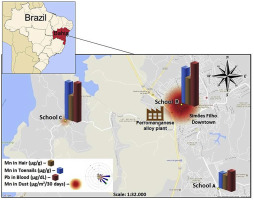Environmental Pollution ( IF 7.6 ) Pub Date : 2017-12-26 , DOI: 10.1016/j.envpol.2017.10.132 Juliana L.G. Rodrigues , Matheus J. Bandeira , Cecília F.S. Araújo , Nathália R. dos Santos , Ana Laura S. Anjos , Ng Lai Koin , Laiz C. Pereira , Sérgio S.P. Oliveira , Donna Mergler , José A. Menezes-Filho

|
Previously, we showed that manganese (Mn) levels in settled dust in elementary schools increased at a rate of 34.1% per km closer to a ferro-manganese alloy plant in the rainy season. In this study, we investigated how this environmental pollution indicator varied in the dry season and if there was an association with Mn biomarker levels in school-aged children. Dust samples were collected with passive samplers (disposable Petri dishes) placed in interior and exterior environments of 14 elementary schools. Occipital hair, toenails and blood samples were collected from 173 students aged 7–12 years from three of these schools, with varying distance from the industrial plant. Mn and lead (Pb) levels were measured by graphite furnace atomic absorption spectrometry. Mn concentration geometric means (GM) in dust fall accumulation in interior environments of schools located at 2, 4, 6 and > 6 km-radii from the plant were 2212, 584, 625 and 224 μg Mn/m2/30 days, respectively. The modelled rate of change of dust Mn levels decreases by 59.8% for each km further from the plant. Pb levels in settled dust varied between 18 and 81 μg/m2/30 days with no association with distance from the plant. Blood lead levels median (range) were 1.2 μg/dL (0.2–15.6), of which 97.8% were <5 μg/dL. Mn in hair and toenails were 0.66 μg/g (0.16–8.79) and 0.86 μg/g (0.15–13.30), respectively. Mn loading rates were positively associated with log MnH (β = 1.42 × 10−5, p < 0.001) after adjusting for children's age; and also with log MnTn (β = 2.31 × 10−5, p < 0.001) independent of age. Mn loading rates explained 18.5% and 28.5% of the variance in MnH and MnTn levels, respectively. School-aged children exposure to Mn, independently of age, increases significantly with school proximity to the ferro-manganese alloy plant.
中文翻译:

小学尘土中锰和铅的含量与学龄儿童接触的生物标志物相关
以前,我们表明,在雨季,小学沉降尘埃中的锰(Mn)水平以每公里34.1%的速度接近铁锰合金厂。在这项研究中,我们调查了这个环境污染指标在旱季如何变化,以及学龄儿童中锰生物标志物水平是否与之相关。灰尘样品是通过放置在14所小学的内部和外部环境中的被动采样器(一次性培养皿)收集的。从其中三所学校的173名7-12岁的学生那里收集枕骨,脚趾甲和血液样本,这些学生与工厂的距离各不相同。通过石墨炉原子吸收光谱法测量锰和铅(Pb)水平。2 /30天,分别。距工厂较远处每公里,粉尘中锰含量的模拟变化率降低59.8%。在结算灰尘铅水平改变18和81微克/立方米之间2天/ 30与来自该植物的距离无关。血铅水平中位数(范围)为1.2μg/ dL(0.2-15.6),其中97.8%为<5μg/ dL。头发和脚趾甲中的锰分别为0.66μg/ g(0.16-8.79)和0.86μg/ g(0.15-13.30)。调整儿童年龄后,锰负荷率与对数MnH呈正相关(β= 1.42×10 -5,p <0.001);以及对数MnTn(β= 2.31×10 -5,p <0.001),不受年龄限制。锰负载率分别解释了MnH和MnTn水平变化的18.5%和28.5%。随年龄增长,学龄儿童的锰暴露量与年龄无关,随学校靠近铁锰合金厂的增加而显着增加。











































 京公网安备 11010802027423号
京公网安备 11010802027423号